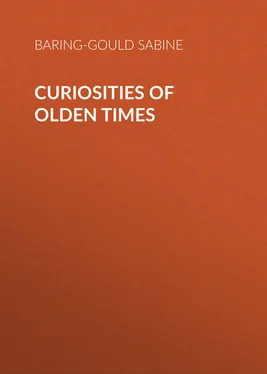Sabine Baring-Gould - Curiosities of Olden Times
Здесь есть возможность читать онлайн «Sabine Baring-Gould - Curiosities of Olden Times» — ознакомительный отрывок электронной книги совершенно бесплатно, а после прочтения отрывка купить полную версию. В некоторых случаях можно слушать аудио, скачать через торрент в формате fb2 и присутствует краткое содержание. ISBN: , Жанр: foreign_antique, foreign_prose, на английском языке. Описание произведения, (предисловие) а так же отзывы посетителей доступны на портале библиотеки ЛибКат.
- Название:Curiosities of Olden Times
- Автор:
- Жанр:
- Год:неизвестен
- ISBN:http://www.gutenberg.org/ebooks/41546
- Рейтинг книги:3 / 5. Голосов: 1
-
Избранное:Добавить в избранное
- Отзывы:
-
Ваша оценка:
- 60
- 1
- 2
- 3
- 4
- 5
Curiosities of Olden Times: краткое содержание, описание и аннотация
Предлагаем к чтению аннотацию, описание, краткое содержание или предисловие (зависит от того, что написал сам автор книги «Curiosities of Olden Times»). Если вы не нашли необходимую информацию о книге — напишите в комментариях, мы постараемся отыскать её.
Curiosities of Olden Times — читать онлайн ознакомительный отрывок
Ниже представлен текст книги, разбитый по страницам. Система сохранения места последней прочитанной страницы, позволяет с удобством читать онлайн бесплатно книгу «Curiosities of Olden Times», без необходимости каждый раз заново искать на чём Вы остановились. Поставьте закладку, и сможете в любой момент перейти на страницу, на которой закончили чтение.
Интервал:
Закладка:
Here is a list of the expenses incurred on the occasion of a sow’s execution for having eaten a child: —

The charter of Eleanora, drawn up in 1395, and entitled “Carta de logu,” containing the complete civil and criminal code for Sardinia, enjoins that oxen and cows, whether wild or domesticated, may be legally killed when they are taken marauding. Asses convicted of similar delinquencies – common enough, by the way – are treated more humanely. They are considered in the same light as thieves of a higher order in society. The first time that an ass is found in a cultivated field not belonging to its master, one of its ears is cropped. If it commits the same offence again, it loses the second ear; should the culprit be hardened in crime, and inveterate enough to trespass a third time, it is not hanged, does not even lose its tail, but is confiscated to the Crown and goes to swell the royal herd.
During the fourteenth and fifteenth centuries, the guilty animals suffered death on the gallows, and our sires considered that such a punishment must strike terror into the minds of all cattle-owners and jobbers, so as effectually to prevent them from suffering their beasts to stray at large over the country. Later on, however, these capital condemnations were done away with, the proprietor of the animal was condemned to pay damages, and the criminal was killed without trial.
One more specimen, and we shall pass to cases coming under Ecclesiastical Courts.
Country folk believe still that cocks lay eggs. This is an old superstition, people holding, formerly, that from these accursed eggs sprang basilisks, or horrible winged serpents.
Gross relates, in his Petite Chronique de Bâle , that in the month of August 1474, an abandoned and profligate cock of that town was accused of the crime of having laid one of these eggs, and was brought before the magistrates, tried, convicted, and condemned to death.
The court delivered over the culprit to the executioner, who burned it publicly, along with its egg, in a place called Kohlenberger, amidst a great concourse of citizens and peasants assembled to witness such a ludicrous execution.
The poor cock no doubt suffered on account of the belief prevalent at the period that it was in league with the devil. A cock was the offering made by witches at their sabbaths, and as these eggs were reputed to contain snakes – reptiles particularly grateful to devils – it was taken as a proof of the cock having been engaged in the practice of sorcery.
The annals of Ireland relate that in 1383 a cock was convicted of a similar offence in that island, and that it suffered at the stake; the heat of the flames burst the egg, and there issued forth a serpent-like creature, which, however, perished in the fire.
We shall pass now to the second part of our subject – namely, proceedings against snails, flies, mice, moles, ants, caterpillars, etc.
It has frequently happened, in all parts of the world, that an unusual number of vermin have made their appearance and destroyed the garden produce, or that flies have been so abundant as to drive the cattle mad from their bites. In such cases the sufferers had recourse to the Church, which hearkened to their complaints and fulminated her anathema against the culprits. The method of proceeding much resembled that already stated as being in vogue in the ordinary tribunals. The plaintiff appointed counsel, the court accorded a counsel to the defendants, and the ecclesiastical judge summed up and gave sentence.
All requisite forms of law were gone through with precision and minuteness. As a specimen we shall extract some details from a consultation on the subject, made by Bartholomew de Chasseneux, a noted lawyer of the sixteenth century.
After having spoken, in the opening, of the custom among the inhabitants of Beaume of asking the authorities of Autun to excommunicate certain insects larger than flies, vulgarly termed hureburs , a favour which was invariably accorded them, Chasseneux enters on the question whether such a proceeding be right. The subject is divided into five parts, in each of which he exhibits vast erudition.
The lawyer then consoles the inhabitants of Beaunois with the reflection that the scourge which vexes them devastates other countries. In India the hureburs are three feet long, their legs are armed with teeth, which the natives employ as saws. The remedy found most effectual is to make a female in the most dégagé costume conceivable perambulate the canton with bare feet. This method, however, is open to grave objections on the score of decency and public morality.
The advocate then discusses the legality of citing insects before a court of justice. He decides that such a summons is perfectly justifiable. He proceeds to inquire whether they should be expected to attend in person, and, in default of their so doing, whether the prosecution can lawfully be carried on. Chasseneux satisfies himself and us that this is in strict accordance with law.
The sort of tribunal before which the criminals should be cited forms the next subject of inquiry. He decides in favour of the Ecclesiastical Courts. The advocate proceeds to convince his readers, by twelve conclusive arguments, that excommunication of animals is justifiable; having done so, he brings forward a series of examples and precedents. He asserts that a priest once excommunicated an orchard, whither children resorted to eat apples, when – naughty chicks! – they ought to have been at church. The result was all that could have been desired, for the trees produced no fruit till, at the request of the Dowager Duchess of Burgundy, the inhibition was removed.
He mentions, as well, an excommunication fulminated by a bishop against sparrows, which, flying in and out of the church of S. Vincent, left their traces on the seats and desks, and in other ways disturbed the faithful. Saint Bernard, be it remembered, whilst preaching in the parish church of Foligny, was troubled by the incessant humming of the flies. The saint broke off his sermon to exclaim, “O flies! I denounce you!” The pavement was instantaneously littered with their dead bodies.
Saint Patrick, as every one knows, drove the serpents out of Ireland by his ban.
This is the form of excommunication as given by Chasseneux: – “O snails, caterpillars, and other obscene creatures, which destroy the food of our neighbours, depart hence! Leave these cantons which you are devastating, and take refuge in those localities where you can injure no one. I. N. P.,” etc.
Chasseneux obtained such credit from this opinion that, in 1510, he was appointed by the authorities of Autun to be advocate for the rats, and to plead their cause in a trial which was to ensue on account of the devastation they committed in eating the harvest over a large portion of Burgundy.
In his defence, Chasseneux showed that the rats had not received formal notice; and, before proceeding with the case, he obtained a decision that all the priests of the afflicted parishes should announce an adjournment, and summon the defendants to appear on a fixed day.
At the adjourned trial, he complained that the delay accorded his clients had been too short to allow of their appearing, in consequence of the roads being infested with cats. Chasseneux made an able defence, and finally obtained a second adjournment. We believe that no verdict was given.
In a formulary of exorcisms, believed to have been drawn up by S. Gratus, Bishop of Aosta, in the ninth century, we find unclean beasts excommunicated as agents of Satan.
From such a superstition as this sprang the numerous legends of the Evil One having been exorcised into the form of a beast; as, for instance, by S. Taurinus of Evreux, and by S. Walther of Scotland, who died in 1214, and who charmed the devil into the shapes of a black dog, pig, wolf, rat, etc. The devil Rush, in the popular mediæval tale of Fryer Rush , was conjured into a horse, and made to carry enough lead on his back to roof a church.
Читать дальшеИнтервал:
Закладка:
Похожие книги на «Curiosities of Olden Times»
Представляем Вашему вниманию похожие книги на «Curiosities of Olden Times» списком для выбора. Мы отобрали схожую по названию и смыслу литературу в надежде предоставить читателям больше вариантов отыскать новые, интересные, ещё непрочитанные произведения.
Обсуждение, отзывы о книге «Curiosities of Olden Times» и просто собственные мнения читателей. Оставьте ваши комментарии, напишите, что Вы думаете о произведении, его смысле или главных героях. Укажите что конкретно понравилось, а что нет, и почему Вы так считаете.












